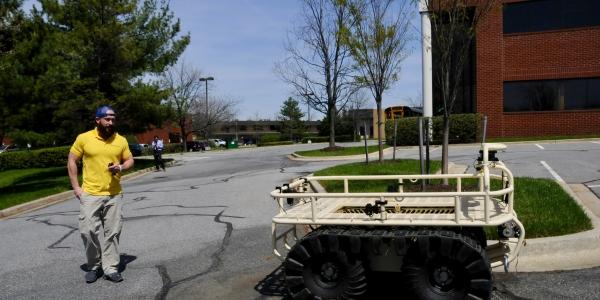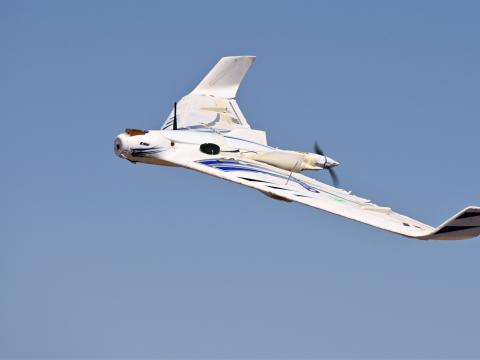The Rise of the Robot Force
Robots have done their fair share of safeguarding troops on the battlefield, from defusing bombs to scouting out caves for insurgents. In spite of their success, or perhaps because of it, the U.S. Defense Department now wants its unmanned ground vehicles to be more than one-trick ponies.
The wars in Afghanistan and Iraq established these systems as battlefield necessities, but the military envisions a much bigger role for them. Think beyond the traditional role as buffer between soldier and threat. “We see today a huge trend in the robotics industry to push these types of systems to more and more users to be used in more and more applications,” says Shahar Abuhazira, CEO of Roboteam, an Israeli company with a U.S. headquarters in Maryland.
Buried roadside bombs killed and wounded large numbers of U.S. and coalition forces and civilians during these recent conflicts and prompted a call to swiftly adapt and field military equipment, such as the mine-resistant ambush-protected (MRAP) vehicle. The casualty rates caused by improvised explosive devices (IEDs) also pushed the military to expedite the fielding of unmanned ground vehicles (UGVs) to protect troops, particularly explosive ordnance disposal (EOD) teams. When conventional maneuver forces took note of the benefits UGVs provided and their practicality, they wanted them too, Abuhazira says.
At the same time, industry began designing multifunctional systems, plug-and-play platforms that can carry explosives, equipment, weapons and even troops themselves. Feasibility and necessity have ignited a market boom similar to what the unmanned aerial vehicle (UAV) ecosystem experienced, Abuhazira submits. “What we have identified in the past five years, and definitely for the future, is that the same thing that happened to the UAVs is going to happen to the UGVs,” he says.
UGVs are expected to catch up to their airborne counterparts in terms of units produced and revenues generated, Abuhazira says. The ground systems are benefiting from the circumstances that helped propel the phenomenal growth of the former, according to Forecast International. Global sales are predicted to increase from $1.49 billion in 2016 to $2.63 billion by 2021, reports research firm MarketsandMarkets.
The need for more versatile technology drives the development of multiuse, autonomous, load-bearing platforms that can assist in a number of functions, from detecting explosives to clearing mines, transporting wounded troops, hauling cargo or neutralizing chemical, biological, radiological and nuclear threats. The Army’s Robotic and Autonomous Systems (RAS) Strategy outlines how the service intends to integrate such future technologies with its forces to “help ensure overmatch against increasingly capable enemies,” the document reads. It calls for increased human and machine collaboration to help future Army forces, operating as part of joint teams, defeat enemy organizations, control terrain, secure populations and consolidate gains. The strategy lists five objectives to guide development and use of ground and aerial vehicles. They should increase situational awareness; lighten soldiers’ physical and cognitive workloads; sustain the force with increased distribution, throughput and efficiency; facilitate movement; and protect troops.
“Achieving the five capability objectives and integrating RAS into existing formations will take time and calls for an evolutionary approach,” reads the document, published in March. “The Army invests now to seize technological opportunities, such as soldier-borne sensors and tethered or teleoperated systems connected to combat vehicles and aircraft, to provide these capabilities while also learning from the integration of RAS and refining concepts and requirements to improve combat effectiveness.”
Accomplishing the five goals should not be that complicated, Abuhazira suggests. Companies must overcome a mere handful of hurdles to successfully modify platforms from specialized EOD roles, for example, to more general use. Approaches that can help make systems more accessible for everyone include ensuring simplicity of operation, upgradability and affordability, Abuhazira offers. “If you want everybody to use it, you need to make sure it is easy to operate, easy to control and easy to maintain,” he says.
Government-fielded systems must meet strict criteria set by the National Institute of Standards and Technology (NIST), which created a laboratory specifically for testing robot performance. Located in Gaithersburg, Maryland, the Robotics Test Facility measures how well robots perform various tasks, such as urban search and rescue, bomb disposal or military ground operations. Obstacle courses assess mobility, manipulation, human-robot interaction, sensing, power and endurance. The 9,600-square-foot indoor space features enclosed isolation bays where testers can evaluate robots’ sensing and endurance under controlled conditions, such as cold, heat and darkness. UGVs big and small can take on pits of gravel and an obstacle course of unconnected wooden blocks that simulates uneven terrain and includes a series of stairs—considered to be among the toughest of tasks for many robotic systems. The facility also provides extensive video and audio systems that capture a robot’s every move so engineers can view its performance.
“NIST has become the best place for us to take requirements and basically to translate those requirements to applications,” says Abuhazira, adding that Roboteam has built a replica of the NIST site at its Maryland office.
Private companies such as Roboteam are not alone in taking advantage of smaller, less expensive and more powerful microprocessors and sensing technologies—the kind giving life to self-driving cars, which some might say are the commercial equivalent of UGVs. Not wanting to be left in the dust, the Defense Advanced Research Projects Agency (DARPA) held the first of three races in 2004 known as the Grand Challenge to accelerate the development of autonomous vehicles. In the first, 15 vehicles competed, but all failed to complete the 142-mile course through the Mojave Desert. Still, the competition was not a total loss. Engineers caught a glimmer of the possible and got a chance to correct mistakes.
Eighteen months later, Stanford University’s entry, “Stanley,” won the second Grand Challenge, completing a 132-mile course in Nevada. DARPA organized its third competition, the Urban Challenge, in 2007, testing driverless vehicles in a staged city environment in Victorville, California. Six of 11 teams successfully navigated the urban terrain, led by a group from Carnegie Mellon University.
The next challenge: developing vehicles that will be both durable and economical. As military and law enforcement communities operate under budget pressures, industry must create platforms that will be in service for several years, Abuhazira says. “We need to make sure those systems will be easy to upgrade and easy to accept more sensors and more payloads. And they must be affordable,” he says. “This is a big challenge—how to create great technology yet make it affordable to buy and to maintain.”







Comments